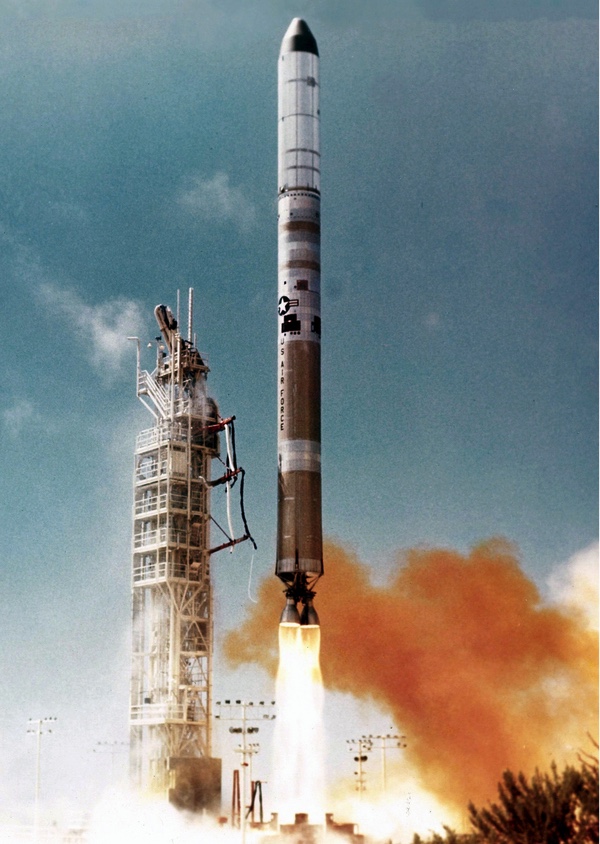Spinning in the black: The Satellite Data System and real-time reconnaissanceby Dwayne A. Day
|
| Using an additional satellite system in high orbit to relay images from ZAMAN satellites in low Earth orbit would be both expensive and complicated. But it also offered advantages over the direct transmission to ground approach. |
This relay satellite, given the obscure name of Satellite Data System, or SDS for short, was developed under a unique management arrangement. Although it carried a highly classified mission payload—“black” in the jargon of the intelligence community—the satellite itself was developed and procured by the unclassified—“white”—Air Force Space and Missile Systems Office, thus straddling the edge of the shadowy world of satellite reconnaissance, with one foot in the light and the other in the shadows. A declassified history by Vance O. Mitchell, “The NRO, the Air Force, and the First Reconnaissance Relay Satellite System, 1969-1983,” describes how this unusual management relationship was developed—and almost fell apart—during its early years.
The CIA and NRO approve data relay
In 1968, CIA official Leslie Dirks, who was then the program manager for the ZAMAN technology program, which had been underway for several years evaluating technology for a real-time imaging satellite, decided to rely on relay satellites rather than onboard data storage and transmission to a ground station for a future reconnaissance satellite. Existing reconnaissance satellites returned their images to the ground on film, which meant that it could be days to weeks from when a photo was taken to when it was seen by human eyes, but near-real-time technology was on the horizon, and required new approaches to imagery transmission. By October 1969, Dirks named his assistant division chief as the manager for the relay satellites. The manager’s name is deleted in the declassified history, but he is described as conservative, detail oriented, and very methodical.
The concept of using a satellite to relay imagery from a reconnaissance satellite was not a new one and had existed since at least the early 1960s, when the Air Force considered using a relay satellite for its early SAMOS reconnaissance satellites. Transmitting high-quality imagery to the ground was difficult. Each image would contain a large amount of data, the satellite would not be able to store many of them, and if the satellite could only transmit the images while in view of a ground station, this would dramatically limit how many images could be sent each day because the satellite would only be over a ground station for a short amount of time: maybe only 15 minutes several times a day. But there was a solution: instead of transmitting signals directly down to the ground, the imagery satellite could send them upward, to a communications relay satellite in a much higher orbit, and that satellite could relay the images to the ground. This approach added complexity, but provided numerous advantages, including increasing available transmission time, and making near-real-time imaging possible.
The National Reconnaissance Office (NRO) was responsible for overseeing the development of intelligence satellites. The NRO included an Air Force component located in Los Angeles known as Program A and publicly acknowledged as the Secretary of the Air Force Office of Special Projects, or SAFSP. The NRO also included a CIA component housed in the CIA Deputy Directorate of Science and Technology's Office of Development and Engineering and known as Program B, which was then leading the ZAMAN effort. Program A and Program B had often battled each other within the NRO during its first decade of existence. In 1969, NRO officials began planning for relay satellites, and by June they became a separate line item in the NRO’s budget. The relay satellite program formally began in spring 1970 when a preliminary evaluation selected a small number of civilian firms for a year-long system definition phase to begin in July of that year. The plan was to downselect to a single company in October 1971.
Using an additional satellite system in high orbit to relay images from ZAMAN satellites in low Earth orbit would be both expensive and complicated. But it also offered advantages over the direct transmission to ground approach, including longer transmission times. An added advantage of the relay system was that it enabled multiple satellite constellations, not just a single satellite at a time. Another advantage was that the imaging and relay satellites would be very far from each other and the ground station and it would be difficult for the Soviets to determine that the satellites were working together, thus increasing operational security.
Many of the details of both programs remain classified, but while these early decisions about the data relay satellite were being made, ZAMAN was still primarily a technology program, not an approved satellite program. Nevertheless, it was clear to those running the National Reconnaissance Program—the formal term for the collection of top-secret intelligence satellites managed by the NRO along with their budgets—that these new systems were going to be very expensive. That created a dilemma for NRO leadership, who sought to be low-key even among those who had security clearance to know about the NRO.
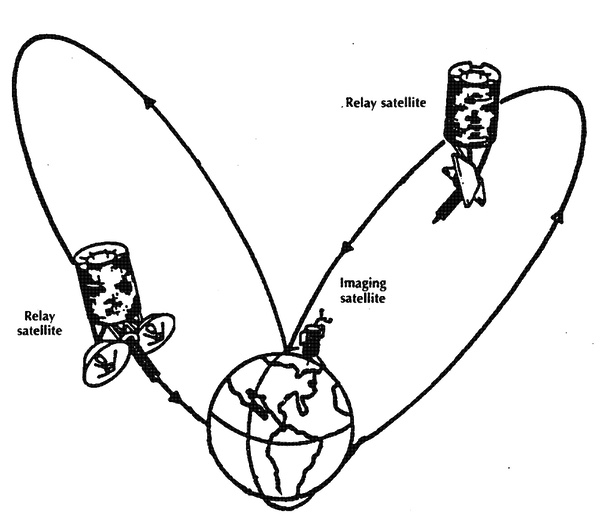 Declassified illustration of the January 1977 constellation of two SDS relay satellites and a single KH-11 KENNEN reconnaissance satellite. From an orbit high over the northern hemisphere, an SDS satellite could be in line of sight with both a ground station in the United States and a low-orbiting reconnaissance satellite on the other side of the world. (credit: NRO) |
Spreading the responsibility and the costs
On August 15, 1969, the NRO’s Executive Committee decided to give relay satellite development to the Space and Missile Systems Office (SAMSO). It was part of the Air Force Systems Command and not affiliated with SAFSP—the classified NRO Program A office—in Los Angeles. Unlike Program A, SAMSO was both overt and completely outside of the NRO. Giving a non-intelligence organization responsibility for a new satellite vital to national reconnaissance was extremely unusual. The only analogous situation was the transfer of a weather satellite program developed and operated by the NRO to the Air Force, which occurred around the same time. The NRO’s ExCom also gave the program an overt designation: the “Satellite Data System,” or SDS.
According to Vance Mitchell’s history of the relay satellite program, there were three reasons to give development responsibility for the Satellite Data System to SAMSO:
- Funding it through Air Force channels would hold down the National Reconnaissance Program budget. The ExCom members were concerned about the NRO budget exceeding a billion dollars, believing that this was a threshold above which their program would receive added political scrutiny from the few elected officials who were cleared to know about the NRO. Other NRO programs had already shifted money into the Air Force side to keep the total NRO budget down, and launch costs for NRO satellites were not part of the NRO’s budget. It was not until the early 1970s that the National Reconnaissance Program budget finally crossed the billion-dollar mark.
- Having SDS as an Air Force program would imply to the Soviets that it was not connected to reconnaissance and therefore enhance mission security.
- The Air Force Satellite Control Facility was responsible for communicating with satellites and had acquired considerable experience. In addition, the Aerospace Corporation had been evaluating data relay satellites in 1968 into 1969 and had become knowledgeable about the subject. Aerospace worked closely with the Space and Missile Systems Office.
SAMSO designated the SDS program as secret with a “special access required” (SAR) annex. There were only two other SAR programs at the time. One was the Defense Support Program (DSP) missile warning satellite, and the other was the military weather satellite program that had started as an NRO satellite system. SAR allowed the release of selected information about the NRO’s communications relay payload without divulging critical items that might compromise its mission. The CIA’s connection to SDS and details of the NRO communications payload were confined to a special compartment within the NRO’s own BYEMAN security system. Anybody requiring access to this information had to be cleared by the NRO.
| Giving a non-intelligence organization responsibility for a new satellite vital to national reconnaissance was extremely unusual. |
Once SAMSO was designated in charge of SDS, it immediately led to questions within SAMSO and the Air Force. Air Force personnel involved in SDS development believed that since the Air Force was providing the personnel, expertise, and offices to run the SDS development, SAMSO was now more than a junior partner in somebody else’s program and should be treated as a full partner. Brigadier General Walter R. Hedrick Jr., Director of Space and Deputy Chief of Research and Development, wanted changes in SDS to make it more responsive to Air Force missions. Hedrick wanted the satellites to serve both Air Force and NRO requirements. He wanted to add secondary payloads to the spacecraft in addition to the communications relay payload.
CIA officials connected to the SDS development believed that the SDS satellites were supposed to have a single NRO communications relay payload and no other missions. They were concerned that the NRO might become a “customer” on its own relay satellite and have the satellite’s covert intelligence mission compromised in the process.
By November 1969 there was pressure to create a management agreement that both sides would accept. CIA officials agreed to allow Air Force secondary payloads on SDS but demanded a guarantee that the intelligence relay mission still had priority. In March 1970, the NRO accepted the management changes demanded by the Air Force while the Air Force guaranteed the NRO communications mission top priority.
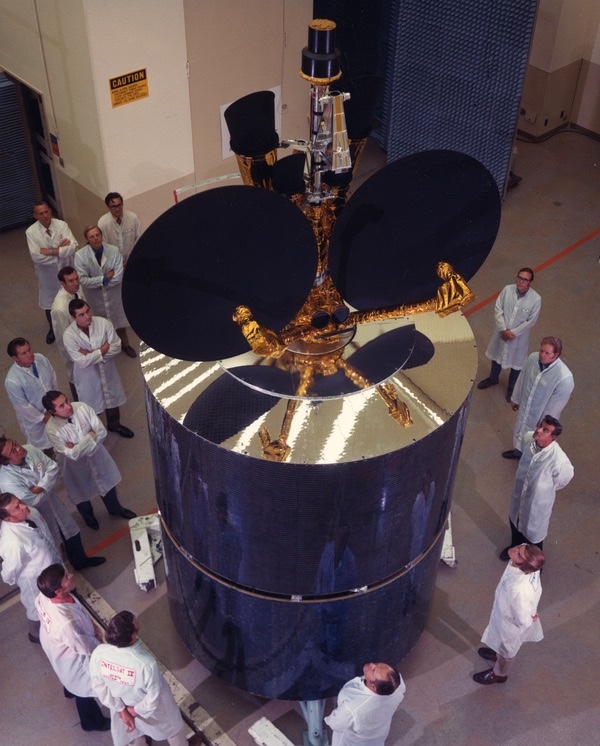 The early SDS satellites were based on Hughes' Intelsat IV commercial communications satellite bus. They had different antennas mounted on top. (credit: Hughes) |
Selecting satellites and payloads for SDS
The contract definition phase for SDS began in August 1970, a few months later than planned. Two contractors were involved: Hughes, and one other aerospace firm whose identity was deleted from the official history but was probably TRW. Both companies, like Hughes, were involved in developing communications satellites.
One of the secondary missions initially proposed for SDS was relaying data collected by Air Force DSP missile warning satellites then in development. But in summer 1970 members of the DSP program office—then operating under the deliberately obscure designation of Project 647—began to have reservations about using SDS relays for DSP satellites. Later in the year the Project 647 office withdrew from participation in the SDS in favor of relaying DSP data directly to the ground. That decision required DSP to stick with its own ground stations, including a politically sensitive ground station in Australia. It also meant that SDS again became a single payload satellite.
This change annoyed Grant Hansen, the Assistant Secretary of the Air Force for Research and Development. Hansen wanted dual or multiple users on SDS. In a January 1971 meeting with several reconnaissance officials, he discussed the options. Hansen had justified SDS in front of Congress as having multiple payloads and did not want to go back and explain why that was no longer the case. To force both SAMSO and the NRO to develop other payloads for SDS, Hansen suspended funding to SDS and placed the program on temporary hold.
In August 1970 three orbital configurations for SDS were being evaluated. The favorite option for several intelligence officials involved putting the relay satellites in geosynchronous orbit. But this was soon rejected. Although it provided good global coverage, it had a high price tag and an unacceptable level of technical risk. The other two options offered less coverage. One of these involved placing satellites in highly inclined, highly elliptical orbits so that they would swing low and fast over the South Pole and then head high up over the northern hemisphere, putting them in line of sight with both a low-orbiting reconnaissance satellite over the Soviet Union and a ground station in the United States.
By early March 1971 Air Force and intelligence officials had identified at least six possible secondary payloads and two were considered most feasible. One of these was relatively minor: a small S-band transponder on each satellite could relay communications between the headquarters of the Air Force Satellite Control and a remote tracking station at Thule, Greenland, ending reliance upon balky land lines.
| The communications relay payload that was developed for the KENNEN used a 60-gigahertz frequency that did not penetrate the Earth’s atmosphere. This meant that if the Soviets listened in on the KENNEN they would detect no emissions coming from it. |
Another communications payload would support the Single Integrated Operational Plan, the Air Force’s nuclear war-fighting strategy. SIOP required communications with Strategic Air Command B-52 Stratofortress bombers and KC-135 Stratotankers. The SIOP at the time depended on ground-based high frequency broadcasts, which were vulnerable to jamming and nuclear disruption. An SDS payload in Earth orbit would be less vulnerable and could provide coverage in northern regions that were hard to cover. But according to Mitchell’s SDS history, the SIOP payload was regarded as a “heavy mother” requiring a helix antenna, transmitters, receivers, additional solar cells and cabling and structures weighing more than 136 kilograms (300 pounds). In late May 1971, the two contractor teams determined that the SIOP payload was not a good candidate and the Air Force ruled it out for SDS.
Grant Hansen was apparently displeased that once again SDS was being reduced to a satellite system with a very limited mission. A review board including representatives from Hansen’s office slashed SDS funding for Fiscal Year 1972 to force program managers to go back and find another payload for the satellites.
General Sam Phillips, who was then in charge of SAMSO but had previously played a major role in running NASA’s Apollo program, protested the funding cut. The relay program was reduced to minimum effort until they could reach an acceptable agreement, or the relay program was taken away from SAMSO and transferred back to the NRO.
Although the specific details are deleted from Mitchell’s history, Mitchell indicates that the SIOP communications payload was eventually incorporated into the SDS satellite design despite its substantial mass and power requirements.
Secrecy means bureaucracy
By spring 1971 there was increasing USAF opposition to the special access requirements (SAR) in place for SDS and the two other space programs because of the difficulties they created for management and operations. Although at least one of the SARs was eliminated around this time, Deputy Director of the NRO Robert Naka wanted to keep the Satellite Data System’s SAR in place because he believed it enabled the transmittal of important information about the relay capability without clearing personnel into the more restricted BYEMAN security system. Finally, in January 1972 Director of the NRO John McLucas removed the SAR from the SDS program and withdrew all relevant material into the NRO’s own BYEMAN security compartment.
General Phillips and one other officer did not think that an entirely covert SDS program was necessary, but they believed that SDS security should be tightened. They and NRO officials agreed that the NRO’s BYEMAN security compartment would be used to protect details on the satellite’s bandwidth, near-real-time operations, transmission, specific frequencies, and the NRO relationship. Documents about the program would be classified at the secret level and would only refer to the secondary payloads. They would also state that SDS satellites were deliberately “over-engineered” in case the Air Force wanted to add more payloads, thus explaining why such a large satellite had a relatively limited communications payload. Previously the NRO payload had been referred to as “User A” but documents would now indicate that User A had been deleted.
The birth of KENNEN
In September 1971, President Richard Nixon formally approved development of the ZAMAN electro-optical imaging system. By November its name was changed to KENNEN, although it would become better known to the public by the designation of its camera system, KH-11 (see “Intersections in real time: the decision to build the KH-11 KENNEN reconnaissance satellite (part 1),” The Space Review, September 9, 2019, and part 2.) With the imaging satellite development now underway, the Satellite Data System finally had a confirmed primary mission and a deadline requiring that it become operational before the first KENNEN satellite was launched. KENNEN was initially scheduled for an early 1976 launch, although this eventually slipped to late in the year.
The communications relay payload that was developed for the KENNEN used a 60-gigahertz frequency that did not penetrate the Earth’s atmosphere. This meant that if the Soviets listened in on the KENNEN they would detect no emissions coming from it, creating the impression that it was passive even while it was sending signals up to the SDS.
At an April 20, 1972, meeting of the NRO’s Executive Committee (ExCom), NRO Director John McLucas was satisfied with existing management arrangements for SDS. SAMSO would continue management, the NRO’s Program B—led by the CIA—would exercise technical oversight, and the Air Force would fund and publicly defend the program to Congress. The NRO officials also established a more streamlined chain of command from SAMSO to the Secretary of Defense level.
The NRO director also moved SDS’s BYEMAN security responsibilities from the CIA-led Program B to the Air Force-led Program A (SAFSP), which strengthened the appearance of a strictly Air Force project and enhanced Air Force authority over the program. He also ordered that there be no further mention of the other payload outside the classified BYEMAN security channel, which meant that only people with BYEMAN clearances could speak or know about SDS’s communications relay payload. Information prohibited from public release included the number of satellites, orbits, technical descriptions, launch dates, finances, and mention of ground facilities. At some point, possibly even early during the 1970s, the SDS program received the classified code name QUASAR. That name was reportedly still being used into the 21st century.
On June 5, 1972, SAMSO selected Hughes to build the satellites. According to a 2011 interview with former CIA and Hughes official Albert “Bud” Wheelon, the winning Hughes design was based upon the company’s proven Intelsat IV spin-stabilized satellite, which weighed more than 700 kilograms. The first Intelsat IV had been successfully launched into geosynchronous orbit in January 1971. Although both Intelsat IV and SDS were spinning drums covered with solar cells, SDS had a different set of antennas mounted to a de-spun platform at its top.
Hughes engineer Anthony Iorillo was one of the people assigned to the SDS program. Hughes had a problem getting sufficient numbers of its own personnel security clearances, so Air Force officers at the captain and major level with the required security clearances were detailed to work at Hughes.
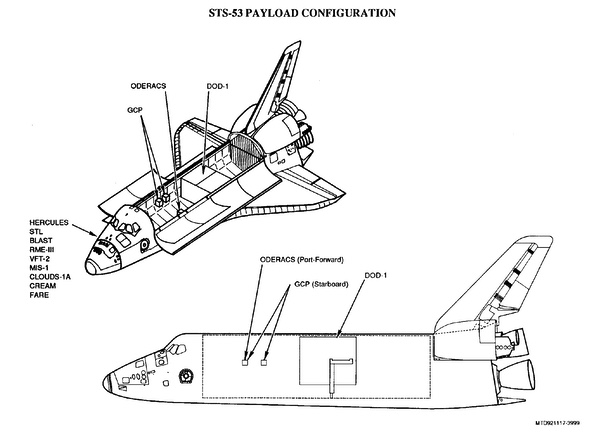 Image from a Rockwell International press kit for shuttle mission STS-53, which launched an SDS block 2 satellite into orbit. The satellite was based on the Hughes Leasat communications satellite bus. They had different antennas mounted on top. (credit: Rockwell International) |
Changes in payloads and operations
The SDS had both the S-band transponder and the SIOP communications payload, but the satellite’s primary payload was always the communications relay for the KENNEN reconnaissance satellites. In August 1974, the Secretary of the Air Force approved adding a third secondary payload to the satellites, the Atomic Energy Detection System. This was introduced starting with the third satellite. Similar nuclear detection payloads—also known as “bhangmeters”—were already carried on Defense Support Program satellites. They could detect nuclear detonations in the atmosphere and space.
| Although the satellites all worked, according to several sources there were early operational problems with getting them to work together. |
According to declassified Air Force documents, the Air Force started procurement with a structural test model designated X-1, followed by a qualification model designated Y-1 and equipped with most of the electronic systems to demonstrate that the satellite could perform the functions it was designed for. The initial plan was to procure four flight spacecraft (designated F-1 to F-4) and refurbish Y-1 to be a flight spare.
By the first half of 1975, testing of X-1 was completed, assembly of Y-1 was completed and it was undergoing initial testing, and fabrication of F-1 was well underway. By November 1975, the Air Force approved procurement of two additional satellites, F-5 and F-6, which were supposed to be compatible with the Space Shuttle.
The first two SDS satellites were launched into orbit atop Titan III-34B rockets in June and August 1976. The first KENNEN was launched in December that same year. Although the satellites all worked, according to several sources there were early operational problems with getting them to work together.
In 1977 a CIA employee sold a copy of the KH-11 user’s manual to the Soviet Union, giving away many of the secrets of the KENNEN satellite. However, Mitchell’s history hints that the Soviet Union did not understand the connection between the KENNEN and SDS satellites until the summer of 1978, confirming a claim that program planners had made about SDS early on, that it would be difficult for the Soviets to figure out that the satellites in highly different orbits were part of the same mission, especially since the KENNEN did not appear to be transmitting while over Soviet territory.
The fourth and fifth SDS satellites were delivered in May and October 1980, and Y-1 was refurbished, redesignated F-5A, and delivered in May 1980. In 1981 the Air Force proposed purchasing satellite F-7. It is unclear how many of these satellites were eventually launched, and one or more may have been retired to a classified storage facility at the end of the program.
Eventually, the first series of satellites was replaced by an updated version designed to be compatible with the shuttle from the start. The second block of SDS satellites was based on Hughes’ Leasat (Syncom IV) design, which was a squat cylinder made to take advantage of the shuttle’s wide payload bay. Five Leasats were built and launched from the shuttle, although the antenna configuration would have been significantly different for an SDS version. It appears that four of these block two SDS satellites were launched. They had the same 4.3-meter diameter as the Leasats, but whereas the Leasats were 4.3 meters tall, the block two SDS satellites had a bigger “antenna farm” on top and were 5.8 meters tall. The Leasats had a deployed mass of 6,894 kilograms, but the block two SDS satellites were anywhere from 2,268 to 4,536 kilograms heavier, depending on the source.
In the late 1990s, the NRO surprisingly unveiled a new communications relay satellite that appeared to be based upon Hughes’ Intelsat VI design that may have been a block three version when later satellites launched on Atlas II rockets. In early 2017, NASA revealed that it had been offered a spare satellite from an unnamed government agency. That satellite was clearly the one seen in the late 1990s. (See “Spinning out of the shadows,” The Space Review, March 13, 2017.) It is likely that any block four SDS satellites were three-axis stabilized and based upon a commercial comsat bus like the earlier satellites.
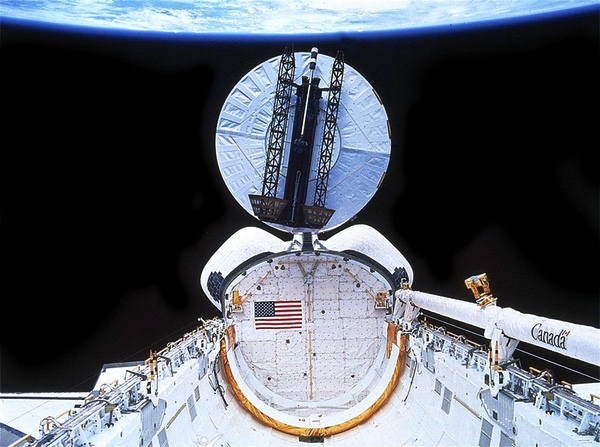 Deployment of a Hughes Leasat communications satellite from the Space Shuttle payload bay. Leasat formed the basis for the block 2 SDS satellites. Leasat had a relatively simple antenna configuration, but the SDS had more antennas, increasing the overall satellite length as well as mass. (credit: NASA) |
The more things change…
In October 1976, the Air Force announced long-range plans that did not include SIOP payloads on future SDS satellites. Instead, the SIOP payloads would be mounted on the planned Air Force Milstar communications satellites. Milstar was a highly ambitious and complex communications satellite system that would support multiple Air Force requirements. When first conceived, the Air Force planned to have Milstar satellites in geosynchronous orbit as well as a constellation of satellites in medium-altitude polar orbits. The satellites in their different orbits would be able to communicate with each other, creating a complex interlocking communications network around the Earth. They were also supposed to be protected against enemy jamming and hardened to survive the effects of nuclear weapons. If it worked as planned, Milstar would provide a tremendous leap in communications capability for multiple Air Force and other users.
| The early Air Force plan was for Milstar to begin operations in 1982, but Milstar soon ran into major development problems. Ultimately, the first Milstar did not launch into space until 1994. |
The CIA’s Leslie Dirks asked members of his staff to evaluate including the SDS relay capability on the Air Force’s Milstar. The initial concept was for three Milstar satellites in polar orbits to perform the relay capability for future KENNEN satellites. But CIA officials quickly grew skeptical about this proposal. Milstar was going to be very complex and face technical risks and problems in development resulting in delays that could affect the KENNEN relay mission. In addition, the NRO’s communications relay payloads would then become secondary payloads for satellites that had many other Air Force missions. CIA officials questioned what would happen if one of the NRO’s payloads failed on a Milstar satellite: would the Air Force launch an expensive replacement satellite simply to fulfill the NRO’s requirement? Two of Dirks’ aides recommended against putting the KENNEN communications relay payload on Milstar and Dirks agreed.
Dirks’ decision proved to be a good one. The early Air Force plan was for Milstar to begin operations in 1982, but Milstar soon ran into major development problems. Ultimately, the first Milstar did not launch into space until 1994. The Air Force had to postpone plans to transfer the SIOP communications payload from SDS to Milstar, and SDS continued carrying SIOP payloads into the 1990s.
Shuffling responsibilities
Dirks’ decision to not transfer the KENNEN communications relay payload to Milstar meant that the SDS program would have to continue, and since the Air Force no longer had a requirement for SDS, the program would have to be transferred to the National Reconnaissance Office, with NRO funding and BYEMAN security measures. In November 1981, NRO Director Pete Aldridge approved the transfer of responsibility for SDS.
Aldridge’s decision created controversy. Brigadier General Jack Kulpa, who headed SAFSP and was therefore the NRO’s Program A director, lobbied to transfer the SDS from SAMSO into Program A, arguing that this would provide continuity and Program A had sufficient experience to run the program, although KENNEN was run by the CIA’s Program B and there was still an ongoing rivalry between personnel in Programs A and B. Yet another suggestion was to create an NRO Program D office solely to manage the relay satellite program.
SDS Director Colonel Clyde McGill and his supervisor, SAMSO commander Lieutenant General Richard Henry, lobbied to leave SAMSO responsible for SDS. They argued that withdrawing SDS into the National Reconnaissance Program benefitted nobody. Both the NRO and the Air Force needed SDS to serve as a “bridge organization” that could work in both the white and black worlds and provide access to evolving technologies for both sides. Although Mitchell’s history of SDS is unclear on this point, apparently Henry and McGill were successful at convincing Aldridge to maintain SDS as a SAMSO-led program, at least for a few more years.
Now that the 50th anniversary of the dawn of the SDS is near, perhaps we will soon learn more about this enigmatic switchboard in the sky.
Note: we are now moderating comments. There will be a delay in posting comments and no guarantee that all submitted comments will be posted.
